Mineral and Rock Abundances
| None (0) | Minor (1) | Few (2) | Common (3) | Frequent (4) | Major (5) | Very Dominant (6) |
| 0% | 0-5% | 5-15% | 15-30 % | 30-50% | 50-70% | 70-100% |
| Name | Cal. | Quartz | Feldspar | Pyroxene | Amphibole | Opaques | Olivine | Biotite | Muscovite | Epidote | Garnet/ Spinel | Ig./Met. Rocks | Sed. Rocks | Grog | Lithics/ Region |
|---|---|---|---|---|---|---|---|---|---|---|---|---|---|---|---|
| Max | 0 | 2 | 5 | 2 | 0 | 1 | 0 | 0 | 0 | 0 | 0 | 4 | 0 | 0 | microlitic, microphaneritic |
| Min | 0 | 0 | 4 | 1 | 0 | 1 | 0 | 0 | 0 | 0 | 0 | 3 | 0 | 0 | PNG |
Representative slides:
| Slide | Site | Possible Origin | Cal. | Quartz | Feldspar | Pyroxene | Amphibole | Opaques | Olivine | Biotite | Muscovite | Epidote | Garnet/ Spinel | Ig./Met. Rocks | Sed. Rocks | Grog | Lithics |
|---|---|---|---|---|---|---|---|---|---|---|---|---|---|---|---|---|---|
| IL_1_90 | Yabob (Png) | Yabob | 0 | 0 | 5 | 2 | 0 | 1 | 0 | 0 | 0 | 0 | 0 | 3 | 0 | 0 | microlitic |
| IL_2_56 | Malai (Malai) | Madang | 0 | 1 | 5 | 1 | 0 | 1 | 0 | 0 | 0 | 0 | 0 | 4 | 0 | 0 | microlitic, microphaneritic |
| IL_2_55 | Malai (Malai) | Madang | 0 | 0 | 4 | 2 | 0 | 1 | 0 | 0 | 0 | 0 | 0 | 3 | 0 | 0 | microphaneritic, microlitic |
| IL_2_36 | Malai (Malai) | Madang | 0 | 2 | 4 | 1 | 0 | 1 | 0 | 0 | 0 | 0 | 0 | 4 | 0 | 0 | microphaneritic, microlitic |
| IL_1_20 | Sio (Png) | Madang | 0 | 2 | 4 | 1 | 0 | 1 | 0 | 0 | 0 | 0 | 0 | 4 | 0 | 0 | microphaneritic, microlitic, lathwork |
| IL_1_6 | Sio (Png) | Madang | 0 | 1 | 4 | 2 | 0 | 1 | 0 | 0 | 0 | 0 | 0 | 4 | 0 | 0 | microphaneritic, microlitic, lathwork |
IL_1_90

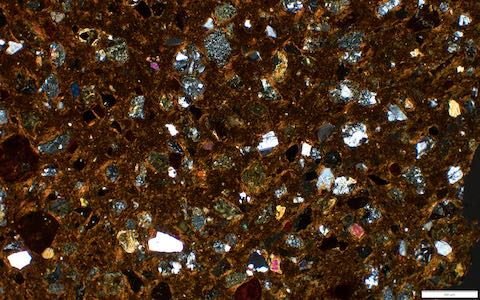
The plagioclase grains (20%) are angular and about 0.3 mm across. Pyroxene grains are colourless to green, angular and less than 0.3 mm in diameter. They make up about 5% of the sample. Volcanic rock fragments (10%), up to 0.5 mm across, are generally weathered and contain clay and feldspar microlites. The opaque minerals (<5%) are angular to subrounded and about 0.2 mm across. There is rare redbrown ferruginized pellets and spinel. The clay is yellow-red-brown.
IL_2_56
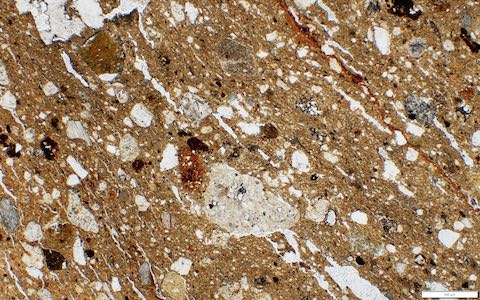
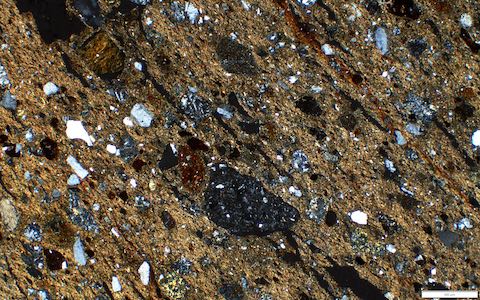
Madang style sherd. CAUTION: Section less than 30microns. Angular and subrounded feldspar grains, are generally 0.2 mm in diameter. Rock fragments are both volcanic and quartzitic. Volcanic rock fragments, up to 0.3 mm in length, generally contain plagioclase, opaques and minor pyroxene. A few grains consist of abundant iron oxide, altered glass and minor plagioclase. The quartz rock fragments are subrounded, about 0.2 mm across and are composed of small quartz mosaics.
IL_2_55
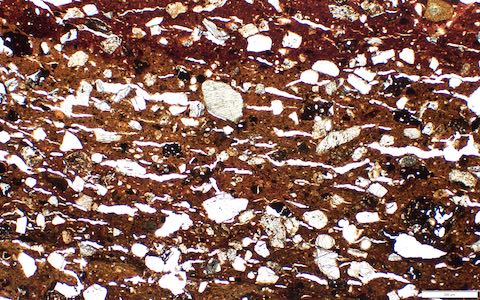
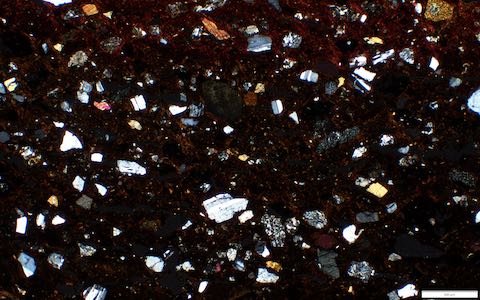
Madang style sherd. CAUTION: Section less than 30microns. Angular to subrounded plagioclase crystals are the main mineral component. Pyroxene grains up to 0.3 m in length. Altered rock fragments generally contain plagioclase microlites and glass. Ferruginized clay clasts up to 1 mm in length are rare. Red iron oxide pellets and black magnetite present.
IL_2_36
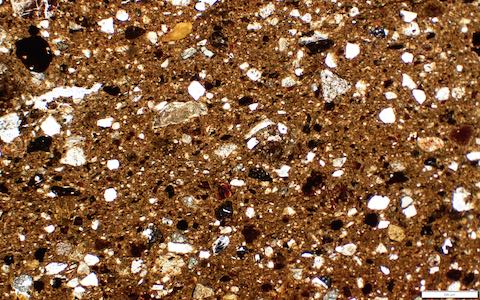
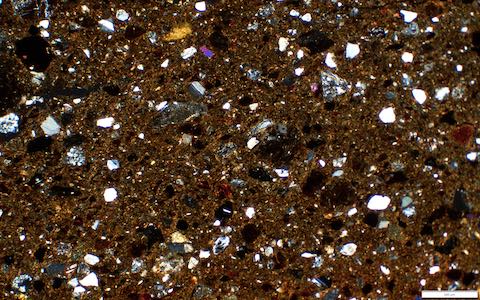
Madang style. CAUTION: Section less than 30microns. Angular quartz and feldspar grains (about 10%), Minor pyroxene grains are all <0.2 mm in length. There are some minor volcanic rock fragments which contain plagioclase, iron oxides and altered glass. Opaque minerals range in size from 0.1 to 0.5 mm in length, and there is less than 5% of those. The clay is red brown.
IL_1_20
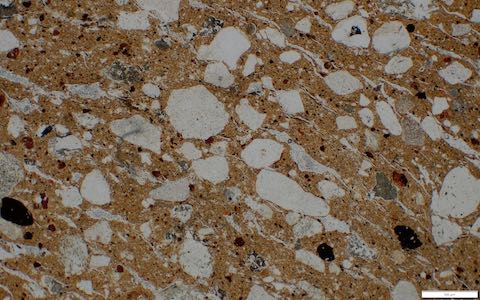
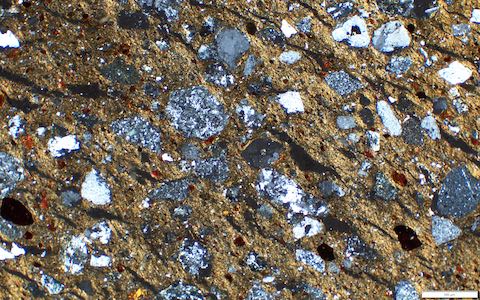
Madang style. CAUTION: Section less than 30microns. Angular feldspar and chert grains make up less than 10% of the sherd and are up to 0.4 mm in length. Volcanic rock fragments are found in two forms, one form consists of long thin plagioclase laths and skeletal iron oxides set in altered glass. The other form contains eutectic intergrowths of quartz and feldspar. The sherd also contains red ferruginized c lasts, iron oxides and minor pyroxene. The clay is red brown.
IL_1_6
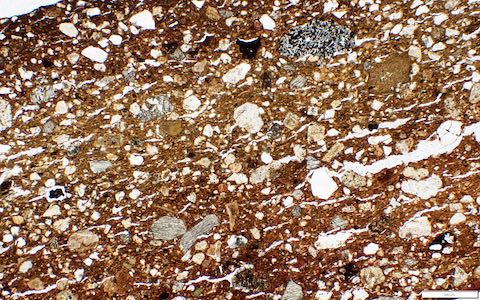
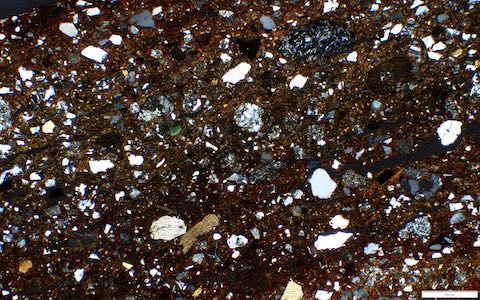
Madang style. CAUTION: Section less than 30microns. Quartz and plagioclase (about 10%) are less than 0.3 mm in length. There are some large volcanic rock fragments which contain plagioclase and pyroxene laths with minor iron oxide and also volcanic rock fragments which contain potash feldspar, plagioclase and quartz. Pyroxene grains are minor components and are up to 0.4 mm in length. There are also ferruginized clasts and iron oxides. The clay is red brown.